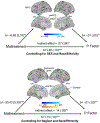Alterations in neural circuits underlying emotion regulation following child maltreatment: a mechanism underlying trauma-related psychopathology
- PMID: 32252835
- PMCID: PMC7541399
- DOI: 10.1017/S0033291720000641
Alterations in neural circuits underlying emotion regulation following child maltreatment: a mechanism underlying trauma-related psychopathology
Abstract
Background: Disruptions in neural circuits underlying emotion regulation (ER) may be a mechanism linking child maltreatment with psychopathology. We examined the associations of maltreatment with neural responses during passive viewing of negative emotional stimuli and attempts to modulate emotional responses. We investigated whether the influence of maltreatment on neural activation during ER differed across development and whether alterations in brain function mediated the association between maltreatment and a latent general psychopathology ('p') factor.
Methods: Youth aged 8-16 years with (n = 79) and without (n = 72) exposure to maltreatment completed an ER task assessing neural responses during passive viewing of negative and neutral images and effortful attempts to regulate emotional responses to negative stimuli. P-factor scores were defined by a bi-factor model encompassing internalizing and externalizing psychopathology.
Results: Maltreated youth had greater activation in left amygdala and salience processing regions and reduced activation in multiple regions involved in cognitive control (bilateral superior frontal gyrus, middle frontal gyrus, and dorsal anterior cingulate cortex) when viewing negative v. neutral images than youth without maltreatment exposure. Reduced neural recruitment in cognitive control regions mediated the association of maltreatment with p-factor in whole-brain analysis. Maltreated youth exhibited increasing recruitment with age in ventrolateral prefrontal cortex during reappraisal while control participants exhibited decreasing recruitment with age. Findings were similar after adjusting for co-occurring neglect.
Conclusions: Child maltreatment influences the development of regions associated with salience processing and cognitive control during ER in ways that contribute to psychopathology.
Keywords: Child maltreatment; P-factor; cognitive control network; emotion regulation; fMRI; salience network.
Conflict of interest statement
Figures




Similar articles
-
Child Maltreatment and Neural Systems Underlying Emotion Regulation.J Am Acad Child Adolesc Psychiatry. 2015 Sep;54(9):753-62. doi: 10.1016/j.jaac.2015.06.010. Epub 2015 Jun 26. J Am Acad Child Adolesc Psychiatry. 2015. PMID: 26299297 Free PMC article.
-
Neurobiological Markers of Resilience to Depression Following Childhood Maltreatment: The Role of Neural Circuits Supporting the Cognitive Control of Emotion.Biol Psychiatry. 2019 Sep 15;86(6):464-473. doi: 10.1016/j.biopsych.2019.04.033. Epub 2019 May 10. Biol Psychiatry. 2019. PMID: 31292066 Free PMC article.
-
Association of Different Types of Childhood Maltreatment With Emotional Responding and Response Control Among Youths.JAMA Netw Open. 2019 May 3;2(5):e194604. doi: 10.1001/jamanetworkopen.2019.4604. JAMA Netw Open. 2019. PMID: 31125109 Free PMC article.
-
Research Review: Neural response to threat in children, adolescents, and adults after child maltreatment - a quantitative meta-analysis.J Child Psychol Psychiatry. 2017 Mar;58(3):222-230. doi: 10.1111/jcpp.12651. Epub 2016 Oct 25. J Child Psychol Psychiatry. 2017. PMID: 27778344 Review.
-
Annual Research Review: Childhood maltreatment, latent vulnerability and the shift to preventative psychiatry - the contribution of functional brain imaging.J Child Psychol Psychiatry. 2017 Apr;58(4):338-357. doi: 10.1111/jcpp.12713. Epub 2017 Mar 13. J Child Psychol Psychiatry. 2017. PMID: 28295339 Free PMC article. Review.
Cited by
-
Corporal Punishment and Elevated Neural Response to Threat in Children.Child Dev. 2021 May;92(3):821-832. doi: 10.1111/cdev.13565. Epub 2021 Apr 9. Child Dev. 2021. PMID: 33835477 Free PMC article.
-
Experience-driven plasticity and the emergence of psychopathology: A mechanistic framework integrating development and the environment into the Research Domain Criteria (RDoC) model.J Psychopathol Clin Sci. 2022 Aug;131(6):575-587. doi: 10.1037/abn0000598. J Psychopathol Clin Sci. 2022. PMID: 35901389 Free PMC article.
-
Migration-related trauma and mental health among migrant children emigrating from Mexico and Central America to the United States: Effects on developmental neurobiology and implications for policy.Dev Psychobiol. 2021 Sep;63(6):e22158. doi: 10.1002/dev.22158. Epub 2021 Jul 22. Dev Psychobiol. 2021. PMID: 34292596 Free PMC article. Review.
-
Increased functional connectivity of amygdalar-frontal pathways in patients with alcohol use disorder and childhood trauma.Neuroimage Rep. 2024 Oct 2;4(4):100223. doi: 10.1016/j.ynirp.2024.100223. eCollection 2024 Dec. Neuroimage Rep. 2024. PMID: 40568362 Free PMC article.
-
Investment by maternal grandmother buffers children against the impacts of adverse early life experiences.Sci Rep. 2024 Mar 21;14(1):6815. doi: 10.1038/s41598-024-56760-5. Sci Rep. 2024. PMID: 38514748 Free PMC article.
References
-
- Beauregard M, Paquette V, & Lévesque J (2006). Dysfunction in the neural circuitry of emotional self-regulation in major depressive disorder. Neuroreport, 17, 843–846. - PubMed
-
- Bernstein DP, Ahluvalia T, Pogge D, & Handelsman L (1997). Validity of the Childhood Trauma Questionnaire in an adolescent psychiatric population. Journal of the American Academy of Child & Adolescent Psychiatry, 36, 340–348. - PubMed
Publication types
MeSH terms
Grants and funding
LinkOut - more resources
Full Text Sources
Medical

